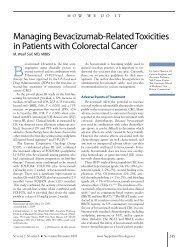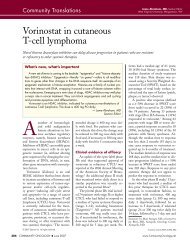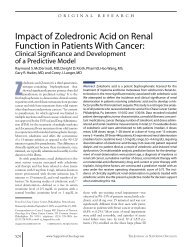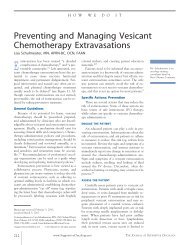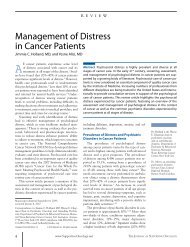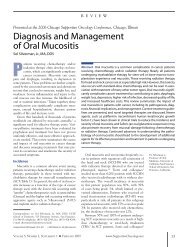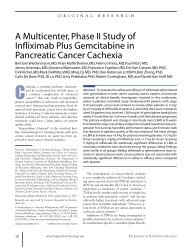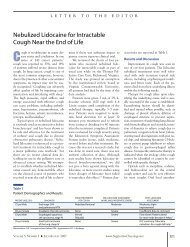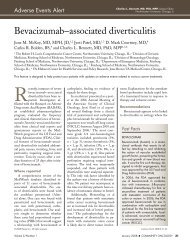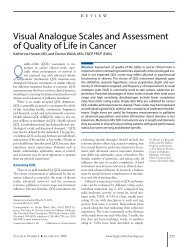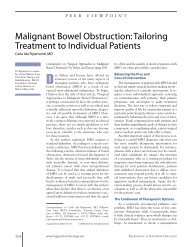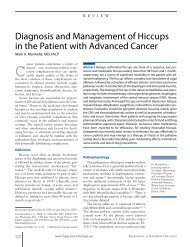Evaluating the “Good Death” Concept from Iranian Bereaved Family
Evaluating the “Good Death” Concept from Iranian Bereaved Family
Evaluating the “Good Death” Concept from Iranian Bereaved Family
You also want an ePaper? Increase the reach of your titles
YUMPU automatically turns print PDFs into web optimized ePapers that Google loves.
Symptom Experience in Patients with Gynecological Cancers<br />
“My eyes seem as though <strong>the</strong>y’re a bit blurred. I feel like I<br />
need eyeglasses. It’s a thing that annoyed me most. It just felt<br />
like <strong>the</strong>re’s a film on your eyes. I wonder if it’s something to<br />
do with hair loss.” (GYP10 at T2)<br />
One participant was worried about her blurred vision being<br />
associated with o<strong>the</strong>r health problems:<br />
“I’ve had slightly sort of, not blurred vision but zig-zaggy<br />
vision that made me a bit ...‘Oh dear,’ you know ...have<br />
I got a brain tumor? ...a strange sort of thing that upsets my<br />
balance.” (GYP08 at T3)<br />
Gastrointestinal problems: nausea, loss of appetite, taste<br />
changes, bowel function, weight changes, and distress. Nausea,<br />
appetite changes, and changes in bowel function (diarrhea or<br />
constipation) were <strong>the</strong> most common symptoms reported in<br />
relation to gastrointestinal system problems that distressed<br />
patients. Patients who reported <strong>the</strong>se occurrences received<br />
ei<strong>the</strong>r chemo<strong>the</strong>rapy or radio<strong>the</strong>rapy, and one received both.<br />
However, <strong>the</strong>se symptoms were of limited extent as women<br />
reported <strong>the</strong>m as mild or of less importance and perceived<br />
<strong>the</strong>m as more manageable. Nausea was only reported by one<br />
participant at T1 and was relieved by prescribed medications.<br />
Ano<strong>the</strong>r participant reported loss of taste throughout <strong>the</strong> year<br />
of <strong>the</strong> study. Loss of appetite was reported by one participant<br />
at T2 and T3. Weight loss, which three of <strong>the</strong> participants<br />
attributed to diarrhea, was also reported:<br />
“My tummy’s a bit off, had a bit of diarrhea, but that’s <strong>the</strong><br />
norm.” (GYP05 at T1)<br />
“I lost weight but <strong>the</strong>n again, I don’t know if that’s down to<br />
eating <strong>the</strong>n going to <strong>the</strong> toilet.” (GYP04 at T3)<br />
However, weight gain was reported by six participants at T3<br />
and five participants at T4, which was <strong>the</strong> key distressing<br />
nutritional problem described, although for some it was seen<br />
in a more positive way:<br />
“I put on weight since <strong>the</strong> radium. But it’s a small price to<br />
pay isn’t it? A bit of weight for all that you’ve gone through.”<br />
(GYP15 at T4)<br />
Numbness and tingling sensations in <strong>the</strong> hands and feet, restlessness,<br />
sleeplessness, and depression. A common physical<br />
problem experienced by three of <strong>the</strong> participants who all<br />
received chemo<strong>the</strong>rapy was tingling sensations of <strong>the</strong> hands<br />
and feet, which increased over time. At T4, three out of 10<br />
participants still experienced numbness and tingling sensations<br />
as described by one participant:<br />
“I was worst after my last treatment, all sorts, my feet, my<br />
fingers were really bad ... always tingly. My feet <strong>the</strong>y’re<br />
numb and I get cramps. It’s weird, <strong>the</strong>y get too cold. It’s<br />
depressing especially if I can’t sleep.” (GYP10 at T3)<br />
“I still got funny toes and fingers. They feel fat and podgy.<br />
It’s depressing. It’s difficult to explain, it feels like because<br />
<strong>the</strong>y’re not dead but ...I know I’ve got <strong>the</strong>m, if that makes<br />
any sense. I find it difficult to spread <strong>the</strong>m.” (GYP10 at T4)<br />
Participants sometimes related <strong>the</strong> sensation to achy joint<br />
pains, as if <strong>the</strong>y were getting <strong>the</strong> flu. This sensation also made<br />
<strong>the</strong>m feel restless at night, contributing to sleeplessness. One<br />
participant related this to <strong>the</strong> side effect of paclitaxel (Taxol);<br />
<strong>the</strong>refore, her medication was changed to liposomal doxorubicin.<br />
Two participants tried to self-manage <strong>the</strong> feeling of<br />
coldness and numbness of <strong>the</strong>ir feet and fingers by soaking<br />
<strong>the</strong>m in hot water. For those participants who experienced<br />
sleeplessness, due to feelings of numbness and tingling sensations<br />
in <strong>the</strong> hands and feet, wearing bed socks or soaking<br />
<strong>the</strong>m in warm water, as well as using reiki and massage, were<br />
<strong>the</strong> management strategies described.<br />
Discussion<br />
This study explored <strong>the</strong> explanations of patients about <strong>the</strong><br />
development and coexistence of symptoms and how patients<br />
attempted to self-manage <strong>the</strong>m. This is one of <strong>the</strong> few studies in<br />
<strong>the</strong> literature, and <strong>the</strong> only one in gynecological cancer, which<br />
has explored clusters of symptoms in a narrative manner. Its<br />
longitudinal nature, unusual in qualitative research due to <strong>the</strong><br />
inherent issues in <strong>the</strong> analysis of such data, was ano<strong>the</strong>r strength<br />
of <strong>the</strong> study as it allowed us to explore shifts in <strong>the</strong> symptom<br />
experience, perception, and meaning over time (although meaning<br />
was fairly stable and participants talked little about it). The<br />
vast majority of <strong>the</strong> increasing literature on symptom clusters is<br />
quantitative, attempting ei<strong>the</strong>r to model clusters through statistical<br />
techniques or to test priori clusters for <strong>the</strong>ir strength of<br />
relationship. However, such clusters may be biased, not only<br />
<strong>from</strong> <strong>the</strong> technique used but also <strong>from</strong> <strong>the</strong> content of self-reports<br />
utilized to collect <strong>the</strong> data. The narrative symptom clusters could<br />
rectify problems with statistical measures as <strong>the</strong>y reflect <strong>the</strong><br />
unique patient experience in <strong>the</strong> patients’ own words and can<br />
assist in <strong>the</strong> development of (patient-centered ra<strong>the</strong>r than statistically<br />
based) symptom clusters that can <strong>the</strong>n be tested quantitatively<br />
with larger samples. Hence, narrative symptom clusters<br />
can be particularly sensitive outcomes and can generate conceptually<br />
meaningful hypo<strong>the</strong>ses for symptom cluster research.<br />
Key symptoms experienced by <strong>the</strong> participants were tiredness,<br />
pain, body image changes, gastrointestinal changes, and<br />
peripheral neuropathy associated with chemo<strong>the</strong>rapy, which<br />
concur with past studies of primarily ovarian cancer patients.<br />
9,10 Out of <strong>the</strong> four clusters identified, one is applicable<br />
to all patients irrespective of treatment and two are clearly<br />
linked with chemo<strong>the</strong>rapy. Symptoms varied in intensity but<br />
tended to subside in a year’s time for <strong>the</strong> majority of patients.<br />
Acceptance brought about self-management strategies to<br />
overcome both <strong>the</strong> physical and psychological effects of cancer<br />
and its treatment, but most important was <strong>the</strong> support<br />
<strong>the</strong>y received <strong>from</strong> families and friends. In addition, <strong>the</strong> fact<br />
that some symptoms decreased over time may be due to some<br />
symptoms being linked to <strong>the</strong> time since <strong>the</strong> end of treatment;<br />
such symptoms could have naturally resolved after completion<br />
of treatment. However, we have limited information on<br />
<strong>the</strong> natural history of symptoms in patients with different<br />
types of gynecological cancer.<br />
68 www.SupportiveOncology.net THE JOURNAL OF SUPPORTIVE ONCOLOGY



